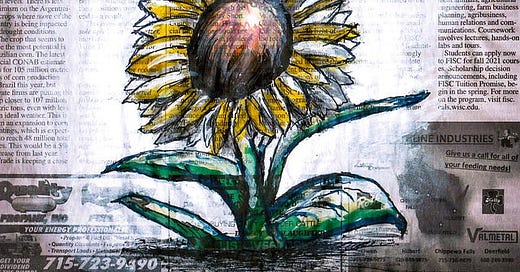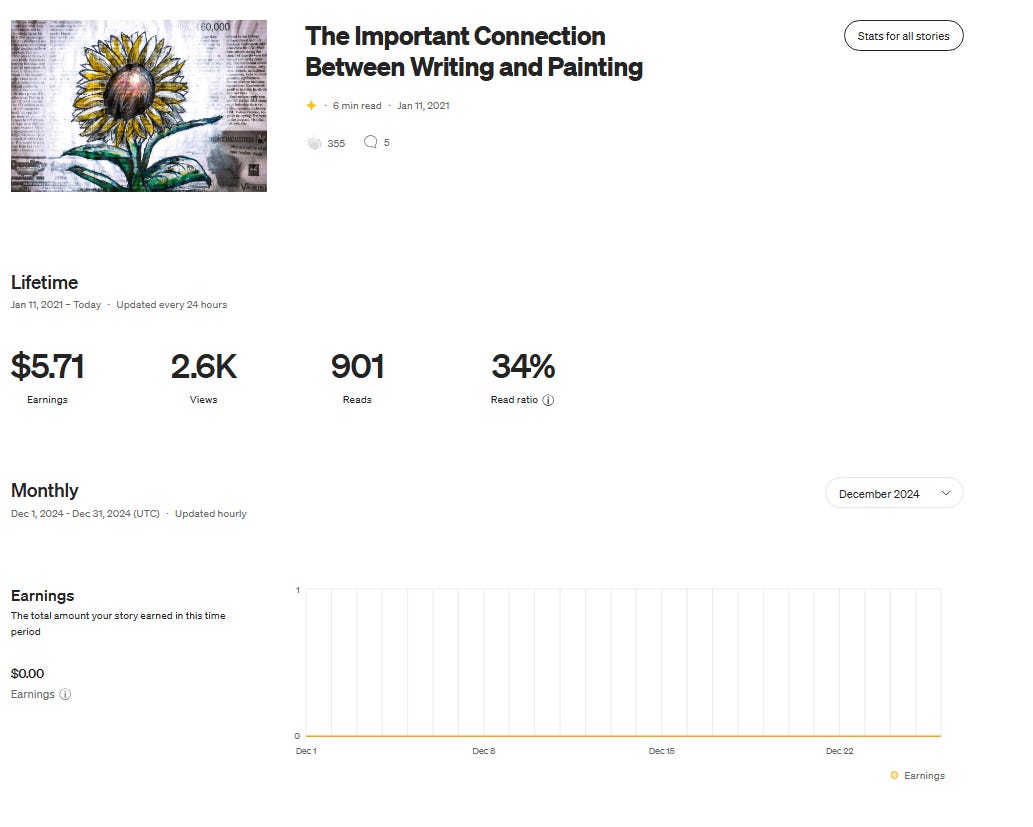How Painting Provides Critical Inspiration That Can Carry Over to Your Writing
We must take full advantage of the inherent similarities between all creative pursuits
This is the second entry in my “The Reckless Writer” column for the Writing Cooperative. It was originally published January 11th, 2021.
My artwork is of the “that’s pretty good for a five year old” variety. I take that as a compliment even though I’m five years old plus forty. There’s some consolation in that most people would say my work is representative of an especially gifted five year old. My paintings generally come out good enough to be used as a featured image on an article, but only after I’ve enhanced them with Photoshop and Lightroom.
For me, the more important aspect of painting is that it is one of the few activities that engages creativity without my mind getting bogged down by sentences or words. I do not believe in the concept of writer’s block. However, there are moments when writers are confronted with a problem and they end up spinning their wheels. It’s important to develop a mechanism to get you back on the road to productivity.
It can sometimes be a huge benefit to take a step back and allow yourself a macroscopic view of your project. The creativity that is involved with working on a painting can compliment your writing process. All writers sometimes find themselves stymied by a blank page. It can be enormously satisfying to put away your typewriter, grab your brushes, and splash that frustrating, infinite emptiness with vibrant color.
When the painting is finished, you might find that you’ve also pulled a writing solution seemingly out of thin air.
Colors
Writers often get so hyper-focused on details that they lose sight of the complexity of what they’re trying to achieve. Writing is multifaceted and every word you place has to work on various levels. A scientist can use a prism to separate a beam of white light into a rainbow of colors. Writers try to hide the colors within a bland beam so that the reader can find the spectrum at their leisure and be delighted by the discovery.
In a way, it’s odd to think of color when it comes to writing. After all, writers work almost exclusively in black ink on a white page. But, like a dream, the greatest writers manage to take words and create beautiful images beyond anything you’re ever likely to see. My guess is that when most readers think of their favorite books, the pleasant memory is accompanied by an explosion of unique colors.
Writers are not confined to the limitations of the visual spectrum. We cannot allow ourselves to forget how beautiful and necessary colors are. Taking a break from composition to dabble in painting helps give your mind a gentle reminder of the tools at your disposal. But the link between painting and writing is more than simply to emphasize the value of color. There are many ways in which you can find an overlap that will guide your thinking in new directions.
Planning
I work on novels for years, but I never spend more than an hour or two on a painting. Yet, in the hour I spend painting I’m able to get a refresher course on the many steps from inspiration to completion that are required for any creative project. The mind is a muscle, and it’s easy to forget that muscles get tired. Sometimes it’s possible to mistake exhaustion for hopelessness or even failure.
Whether you are working on a book or a painting, there are many moments along the way when it doesn’t seem like the project is going to work. Neither a book nor a painting looks right until it is finished. You need to develop double vision so you can see the project in its current state while keeping in mind a shadow image of where you are headed. Maintaining that dual perspective is exhausting.
If you’ve been working on a single chapter for a few days, it’s not unusual to start feeling hopeless about how it’s turning out. Stepping away to sling some paint helps remind you that the writing is just one small step in the process. You’ll have ample time to fix the work as you continue, or even completely discard it if that should prove necessary. Painting helps establish the appropriate context of your expectation.
Visualization
I’m sure that a real artist is just as inclined to be daunted by the prospect of a blank page as a writer is. For them it is a true expression of art, whereas for me painting is just an exercise for a quick mental tune up. But whether you’re an artist or a writer, the skill of visualization is important.
When you’re painting, you need to consider the balance of light and dark areas in order to give your image depth. If you sit for a minute, you can “see” what you want to achieve and then try to replicate it on the page.
This talent for visualization is the same skill you need when you’re imagining a character for a description. Mentioning highlights of color on a landscape or hairstyle can be a very effective tool in bringing a scene to life.
The more you practice visualization, the better you get at it. It doesn’t matter if you’re doing it for a book or for a painting. The more fully realized a project is in your mind, the easier it is to give birth to the final product in the real world.
Planning
An artist generally doesn’t start at one corner of a canvas and proceed methodically until the whole space is covered with the final image. Instead, they work the canvas all at once. They start with an outline and then slowly fill it out being mindful of the element they’re working on even while maintaining an awareness of how each element influences the whole picture.
When painting, I usually start out with the light areas and then get steadily darker as needed. The picture takes shape, and then I finish up by adding highlights with an ink pen.
In writing, you must also have an awareness of the whole work even as you’re working on a single scene. Just as I jump around on a canvas, I also feel free to jump around in the manuscript I’m writing. I always follow my inspiration. When I have the ending, I write it. When I have the first scene, I jump back there. Sometimes I write scenes without a complete awareness of where they will end up fitting.
In the late stages of a novel, I assemble the scenes and see how they look. At that point, the red pen comes out and I do the finishing work. Sometimes I discover that whole chapters have to be removed, sometimes I understand the need for scenes that I am missing. The whole novel grows organically, but it grows more like a bed of moss than a tree. Little bits rise up here and there, and you have to stand back to understand how it all fits together.
Painting on newsprint
I enjoy painting, but I don’t like spending much money on it. For that reason, I keep my copies of the local paper and I cut up sections to use as my canvases. I happen to like the way a painting looks on newsprint, but in writing this article I came to a comical realization. Perhaps the fact that I’m a writer first and foremost is why I like to see a colorful image superimposed on written words.
For every writer, the blank page is the canvas and words are the colors on our palette. Perhaps someday it would be fun to take pages from colorful books like Peter Pan or Alice in Wonderland and paint the scenes over the very text that describes them. But then again, I love books too much to deface a novel in that fashion.
In every creative pursuit, artistic individuals are confronted with unique challenges. Although writing and painting emphasize different skill sets, there are similarities that can provide you with the kind of direction that might provide a means of fortifying your weaknesses. Sometimes the best way to discover a solution to a writing problem is to allow yourself to think in a completely different direction.
Answers where you least expect them
Writers tend to be driven individuals, but sometimes the harder you look for something the less likely you are to find it. You have to trick yourself into looking in exactly the place you think the answer is least likely to be. Often, you’ll be delighted to find it there.
Now that advice sounds like something Lewis Carroll might have suggested. I don’t think it’s an accident that his notebooks are also filled with beautiful and artistic drawings.
This publication is reader sponsored. If you have the means, please consider sponsoring at whatever level is comfortable for you!
My CoSchedule referral link
Here’s my referral link to my preferred headline analyzer tool. If you sign up through this, it’s another way to support this newsletter (thank you).
Here’s how this story performed on Medium. This was published before I had much of a following there:







A great metaphor. Long-term fiction and painting both require extensive prep work, a solid base, and a creator with a strong mindset to work.
I agree with your theory, Walter. I like to illustrate my posts and newsletters, and occasionally Medium articles, too. Early sketches help me organise my thoughts and formulate headlines.